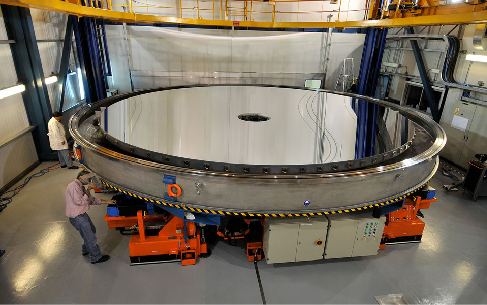| << Chapter < Page | Chapter >> Page > |
By the end of this section, you will be able to:
Since Newton’s time, when the sizes of the mirrors in telescopes were measured in inches, reflecting telescopes have grown ever larger. In 1948, US astronomers built a telescope with a 5-meter (200-inch) diameter mirror on Palomar Mountain in Southern California. It remained the largest visible-light telescope in the world for several decades. The giants of today, however, have primary mirrors (the largest mirrors in the telescope) that are 8- to 10-meters in diameter, and larger ones are being built ( [link] ).

The decades starting in 1990 saw telescope building around the globe grow at an unprecedented rate. (See [link] , which also includes websites for each telescope in case you want to visit or learn more about them.) Technological advancements had finally made it possible to build telescopes significantly larger than the 5-meter telescope at Palomar at a reasonable cost. New technologies have also been designed to work well in the infrared, and not just visible, wavelengths.
| Large Single-Dish Visible-Light and Infrared Telescopes | ||||
|---|---|---|---|---|
| Aperture (m) | Telescope Name | Location | Status | Website |
| 39 | European Extremely Large Telescope (E-ELT) | Cerro Armazonas, Chile | First light 2025 (estimated) | www.eso.org/sci/facilities/eelt |
| 30 | Thirty-Meter Telescope (TMT) | Mauna Kea, HI | First light 2025 (estimated) | www.tmt.org |
| 24.5 | Giant Magellan Telescope (GMT) | Las Campanas Observatory, Chile | First light 2025 (estimated) | www.gmto.org |
| 11.1 × 9.9 | Southern African Large Telescope (SALT) | Sutherland, South Africa | 2005 | www.salt.ac.za |
| 10.4 | Gran Telescopio Canarias (GTC) | La Palma, Canary Islands | First light 2007 | http://www.gtc.iac.es |
| 10.0 | Keck I and II (two telescopes) | Mauna Kea, HI | Completed 1993–96 | www.keckobservatory.org |
| 9.1 | Hobby–Eberly Telescope (HET) | Mount Locke, TX | Completed 1997 | www.as.utexas.edu/mcdonald/het |
| 8.4 | Large Binocular Telescope (LBT) (two telescopes) | Mount Graham, AZ | First light 2004 | www.lbto.org |
| 8.4 | Large Synoptic Survey Telescope (LSST) | The Cerro Pachón, Chile | First light 2021 | www.lsst.org |
| 8.3 | Subaru Telescope | Mauna Kea, HI | First light 1998 | www.naoj.org |
| 8.2 | Very Large Telescope (VLT) | Cerro Paranal, Chile | All four telescopes completed 2000 | www.eso.org/public/teles-instr/paranal |
| 8.1 | Gemini North and Gemini South | Mauna Kea, HI (North) and Cerro Pachón, Chile (South) | First light 1999 (North), First light 2000 (South) | www.gemini.edu |
| 6.5 | Magellan Telescopes (two telescopes: Baade and Landon Clay) | Las Campanas, Chile | First light 2000 and 2002 | obs.carnegiescience.edu/Magellan |
| 6.5 | Multi-Mirror Telescope (MMT) | Mount Hopkins, AZ | Completed 1979 | www.mmto.org |
| 6.0 | Big Telescope Altazimuth (BTA-6) | Mount Pastukhov, Russia | Completed 1976 | w0.sao.ru/Doc-en/Telescopes/bta/descrip.html |
| 5.1 | Hale Telescope | Mount Palomar, CA | Completed 1948 | www.astro.caltech.edu/palomar/about/telescopes/hale.html |

Notification Switch
Would you like to follow the 'Astronomy' conversation and receive update notifications?